Sony Tablet Z: waterproof tablet on humanized Android
Before we talk about the main character of this post, you need to make a small introduction. Because it appeared not from nowhere, but after the combined efforts of Sony Mobile (nee Sony Ericsson) and the “big” Sony. And it all started not from the tablet.
In January of this year, Sony showed the Xperia Z smartphone at CES. A wave of enthusiasm swept across the Internet. “The best Android device in the entire history of the platform,” “What iPhone 5 should have been,” “The triumph of design and hardware capabilities,” as gadget writers called it. I, too, was at that presentation in Vegas and, holding the device in my hands, I decided to postpone the enthusiasm until thoughtful acquaintance with the final version. And then all these first glances at the preliminary reviews, frankly speaking, slightly lifted up all but young SMM experts.
After the Xperia Z went on sale, the same authors began to scold him. Mainly for insufficient viewing angles. To me, this claim seems a little strange. With the current screen sizes for top-end smartphones (5 inches!), Text and pictures from them are perfectly visible from a distance of a couple of meters. If you drive in a car - that's okay. If you travel by public transport, and even at rush hour, the neighbors are happy to read a book, mail, Twitter, Facebook and look at pictures with you. The viewing angles of the Xperia Z are noticeably wider than they are described in the forums. But, really, it’s not very easy to see the information on the screen from the side. And this makes the smartphone, a personal computer of the beginning of the XXI century, truly personal. Although, probably, some network exhibitionists are annoyed.
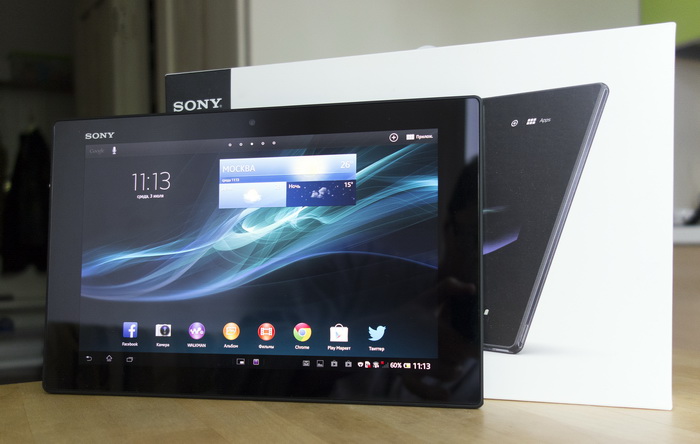
I myself have been using Xperia Z as a second smartphone for several months and consider it the best of all that has ever happened with Android. This is a very integral device, the developers of which have good taste and common sense. It is practical, elegant, stable - and, in addition, photographs well. Do not forget about moisture resistance. Indeed, it is very convenient when you can get into the rain without fear with the phone, not to mention more ... intimate situations. A quick battery was causing some disharmony, but, firstly, all the flagships are guilty of this, and, secondly, the recently released firmware with Android 4.2.2 substantially corrected the situation. I got the feeling that the Xperia Z picked up a banner that fell out of the hands of the Samsung Galaxy S III. It was this Korean device that at one time very pleased with accuracy and thoughtfulness, however, in S4, developers are overly addicted to performance at the expense of efficiency. There are many whistles and rattles, but they fit sluggishly into everyday life. Xperia Z is almost devoid of jewelry, but the wholesteam, the enthusiasm of developers went into dopilivaniya and thinking out the functionality of the platform. And that Android, which I see in Xperia Z, is very different from the bloody, gloomy freebox of naked Android. Perhaps this does not look as impressive as the shell of HTC One, but to hang ryushechek on a google phone - you don’t need a big mind. But to restore order ...
At MWC, they showed the Tablet Z tablet, made in the same aesthetics as the Xperia Z. They are really very similar, like a smartphone stretched to a 10-inch diagonal screen, along the way, slightly changing the proportions. And the filling is very similar. Colleagues began to praise him, but again I preferred to wait for the final version. The fact is that I have a rather complicated relationship with Android tablets. There is no doubt that in terms of functionality, the Google platform is equal to iOS, and in some ways has overtaken. But according to the degree of ease of use on tablets, until the last moment everything was pretty sad. No matter how archaic the iPad interface seems, it is very convenient to use it. And Android ... Small spaces, up to 5 inches inclusive, the platform serves well. But it is worth exceeding this threshold, as the telephone interface begins to look ridiculous. This endless segmentation of devices on Android is affecting, which does not allow you to make widgets, applications and icons once and for all. And, of course, to do well. So, such high-tech Christmas toys are obtained at the exit: you can use it, but there is no joy.
I have been using the Sony Tablet Z for about a month now, and I must say that this is a very big step towards the user for the Android tablet. Maybe even too big. But let's talk about everything in order.
About iron
As I wrote above, from a hardware point of view, the Tablet Z is very similar to the Xperia Z. Everything works on a Qualcomm quad-core processor with exactly the same frequency as in a smartphone (1512 MHz). In the official specifications, in the first case it is called S4 Pro, and in the second, telephone, APQ8064 + MDM9215M, but I dare to assume that this is generally the same chip. The same graphics core and almost identical results in benchmarks hint at this (a study of the detailed description confirmed the correctness of the assumptions - the same Qualcomm APQ8064 + MDM9215M in Tablet Z). The amount of RAM is also the same, 2 GB.

If you look closely, in the background you can see the protruding corners of the Dell Latitude 10 tablet on Intel Atom and Windows 8. With the same dimensions and a slightly thicker case, it works on battery one and a half times longer ...
The resolution of the TFT-screen with a diagonal of 10.1 inches is 1920x1200 pixels. An additional strip of pixels is intended for the service strip. As in the Xperia Z, there are no hardware buttons here, and in order not to eat up the space at FullHD, we took such a step (the Xperia Z still eats away some of the screen). I really liked the matrix: the colors are natural, the viewing angles are enough to watch a movie with at least five, the margin of brightness is optimal. You can, of course, be sad that neither IPS nor AMOLED. Or you can just watch and have fun. A little puzzling is the wide frame around the screen, making the Tablet Z more bulky than we would like. Honestly, I do not really understand - why is this done? Certainly, the problem is not the lack of space for electronic filling: as we recall, it is almost identical to the telephone, and therefore free space should be a dime a dozen. According to the resultsopening the tablet , manufactured by Chipworks, it can be assumed that Sony either did not have time, or could not condense the arrangement of internal elements, which is why the case is full of voids. The late Jobs would probably have brought to tears for this and lowered him from the stairs (a video of the process of disassembling the Tablet Z can be seen here ).
This is especially strange combined with the desire of designers to make the case one of the thinnest in the world. It is really surprisingly thin - only 6.9 mm versus 7.9 for the Xperia Z. This gives an excellent impression, but the trouble is that you can’t defy such beauty without a cover, these very thin millimeters are not very noticeable in it ... In general, a strange impression. A feeling that just did not have time to bring to mind. At least for the next incarnation it turned out. At the same time, you can add a mirror substrate, and now the screen fades noticeably in the sun, although the tablet somehow asks for the beach.
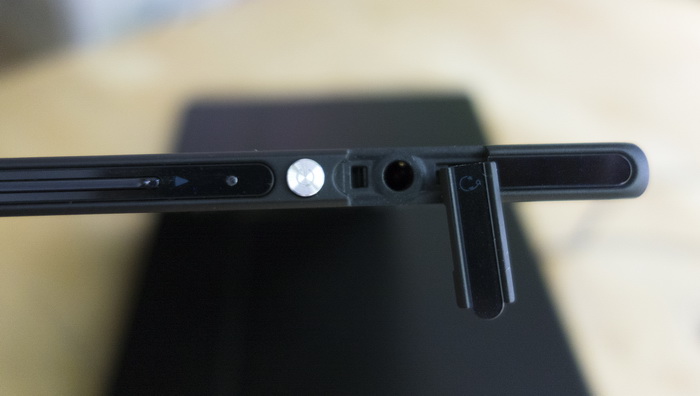
All important openings are hidden under the plugs. In the new smartphone Xperia Z Ultra managed to do without plugging the headphone jack, but here the stub is still in place.
After all, the case in it is dust and moisture resistant. The level of protection is the same as that of Xperia Z: it is better not to swim in the sea, but the tablet can withstand short-term immersions in fresh water and work in a room with high humidity (in the bathroom, for example) without consequences. The main thing is not to forget to tightly close the plugs. They cover all openings except for speakers and a microphone, so it’s probably best not to be greedy and buy a dock for charging, otherwise pulling the plug back and forth will quickly begin to annoy. And in a fit of irritation it can once be torn off. In general, I already bought a docking station for a smartphone, since the question price is about 900 rubles. It will be necessary to see for the tablet, if we get along.
Speaking of speakers. There are two of them, and they are quite loud. So much so that without choking, they are able to cover a 10-meter room. But, unfortunately, only a small part of the mid-frequency spectrum is available to us, in which you can parse the voice of singers or actors, but the nuances of music or other soundtrack are very unlikely. Therefore, connoisseurs of high-quality sound will have to wear headphones, since the sound path is very decent and even 64-ohm models are well pumped. In general, the sound subsystem in Sony mobile devices is very pleasing. When I don’t take an iRiver Astell & Kern player with me, I listen to music exclusively on Xperia Z, where it sounds a little more analog and tube than on iPhone 5. By the way, the most advanced guys can connect fashion speakers with NFC support. The pairing process looks very impressive.

Tablet Z seems to be taking part in the competition for the most concise design of the back ...
Cameras, as expected, two pieces. The front gives a picture up to 1920 × 1080 pixels, inclusive. In Skype, Hangouts and other video chat applications, it behaves well. Fans of shooting dacface will also be pleased, lips are large and convincing. The main camera is 8-megapixel, with the mobile version of the Exmor R sensor. Mobility is achieved at a considerable price, and from the original Exmor R, in fact, only the name remains. No, except for jokes. The sensor of the same name is used, for example, in the Sony DSC-RX100 compact camera, and the picture quality there is an order of magnitude higher. Therefore, we reject the marketing husk and say simply: the camera is at the level of the flagship smartphones of the previous generation or slightly lower. You can shoot with pleasure, but in smartphones you can already find significantly more interesting options (at the last moment I found
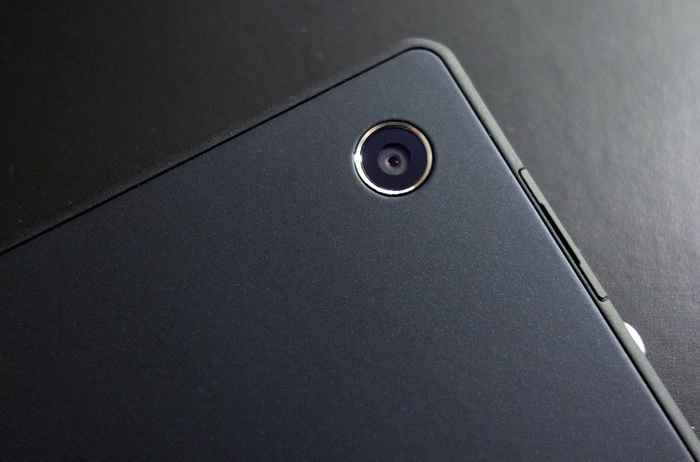
There is a camera, no flash. However, in tablets it is not common.
There are two versions of the Tablet Z - only with WiFi or with LTE / 3G in the appendage. They gave me a second one for the experiments. There is nothing special to say here: everything works without incident. WiFi, however, is quite pessimistic, and gives out only one division where the iPad mini shows the maximum signal level. However, this does not affect the speed and stability of the connection. If the router supports the 5-gigahertz range, you can switch to it when watching HD movies over the air (for example, from a home NAS) - for greater stability. Unfortunately, the number of 2.4 GHz networks in large cities has already exceeded all reasonable limits, and they greatly interfere with each other.
The amount of on-board flash memory available to the user is about 10 GB. For applications and music, this is most likely enough, but for movies you will have to add a microSD card. The tablet easily digests even 64-gigabyte copies, so there should not be problems with a lack of space.
The battery capacity is at least 6,000 mAh (that’s exactly the “minimum” is written in the detailed description. It is possible that capacity will be increased in new revisions). The manufacturer promises up to 9.5 hours of video playback, but I do not advise you to flatter yourself. It is possible that such an indicator can be achieved, but only with the screen off and network interfaces turned off. If the screen is still not turned off, the battery will last for about 6 hours of continuous operation under load. And even a little less. Owners of iPads giggle maliciously and, in general, do the right thing. No, seriously - why wasn’t it possible to make a tablet a millimeter thicker? Given the area, this would increase the battery capacity by a good third, and then Tablet Z would confidently compete with the same iPad. I asked the Sony Mobile Chief Marketer about this, and he said something people are thirsty for a slim body and is ready for this for any restrictions. Marketers, of course, know better. But I, having bought a Sony branded case (not cheap, by the way, 3000 rubles), I no longer see and feel the vaunted subtlety. But the battery discharge is very noticeable. Moreover, it charges about the same as it works. Under normal conditions, it’s not scary - set it at night and forgot to sleep. But on trips sometimes upsets.

It is easy to see that the tablet (bottom) is really a little thinner than the Xperia Z smartphone (top).
At the same time, continuous operation is quite rare. Usually you watch movies in non-stop mode on a train or plane, and the rest of the time you use a tablet on raids. Turned on, poked for half an hour, laid it on the table. In this mode, the Tablet Z, according to the subjective feeling, lives no less than the iPad. To save battery power, you can enable Stamina mode, which disables all synchronization when the screen is off. And then - with a typical home use model - the tablet can be charged almost once a week.
Summing up the subtotal for the iron part, we can say that it is ... reasonable, although not perfectly balanced. There are no frills that can impress a young lover to buy miracle gadgets for daddy’s money. But in general, the hardware is decent, the performance of the tablet is pleasing to the eye. If only there would be a narrower frame around the screen, but the battery is more powerful - then it would be very good. But how many moisture resistant tablets with such characteristics do you know? That's it.
About software
When you turn on Tablet Z for the first time, you get the full feeling that you have an enlarged Sony smartphone in front of you. This feeling almost does not wane over time. Indeed - a set of applications, the color scheme, everything is exactly the same. This, in general, is not bad, because Sony’s taste is all right, and branded applications are made with high quality and I don’t especially want to replace them (except, perhaps, the video player, because the built-in shows excessive moodiness for the formats). Again, they didn’t forget about the weather widget, which fans of Sony smartphones really like (deservedly!) And some even don’t switch to alternative firmware because of it (the tricky widget does not start there).
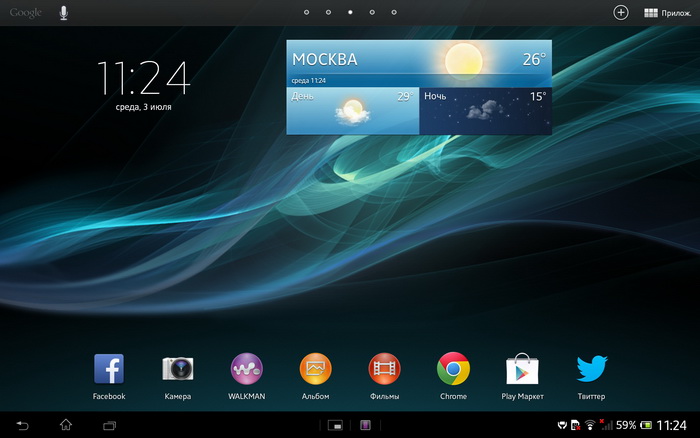
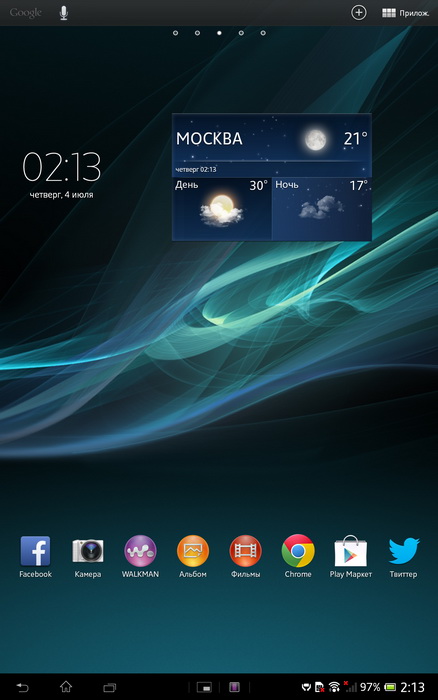
In the upright position, the resemblance to a giant phone only intensifies.
The tablet works on Android 4.1.2. Version 4.2.2 is expected soon, and judging by the fact that it has already begun to be distributed to phones, it does not take long to wait. There is hope in a slight increase in battery life. If it worked on a smartphone, then suddenly a small miracle will happen?
The company launcher is simple, neat, and allows you to place up to 48 application icons on one screen mixed with widgets. There are five screens in total, so you can thoroughly settle in. Very useful were the mini-applications with which Sony has been experimenting since the last generation of smartphones. This is a cross between a full application and a widget. So, with one click you can call the calculator, window browser, timer, remote control, and if the pre-set is not enough - in Google Play you can download another fifty additional softinks. On the phone, they would have looked rather strange, but here just right. A nice example of "thinking" of Android.
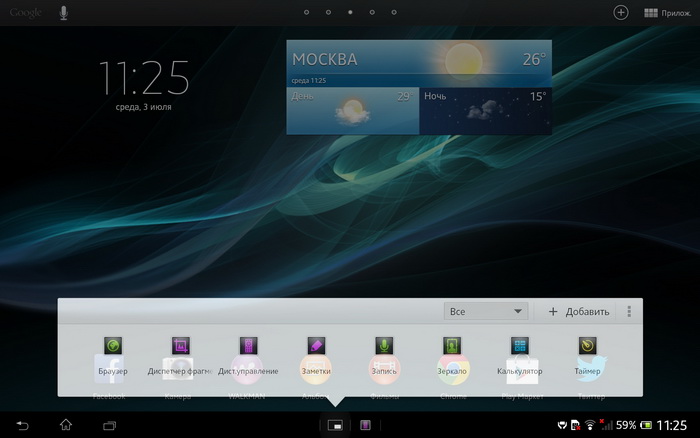
The gadget launcher The mini

browser works on the background of cards

Using another gadget you can check whether everything is alright with the face

This is only part of a set of additional gadgets on Google Play.
I would also like to mention a proprietary application with the simple name “Dist. control". This, as you might guess, is a universal remote control. An infrared port is hidden on the upper edge of the Tablet Z, and this allows you to control almost any equipment. The database of devices in the database is simply huge, and there are not only televisions, but also players, receivers, speakers, etc. etc. If something suddenly doesn’t turn out, you can train the application manually by feeding him commands from the device’s native console. It seems to be nonsense, but very convenient. You used to lie on the couch, do research, and suddenly you want to watch the Rossiya TV channel. Well, to soak up optimism. To get up at the remote control is too lazy, and here is a raz - and turned it on in two clicks. Good!
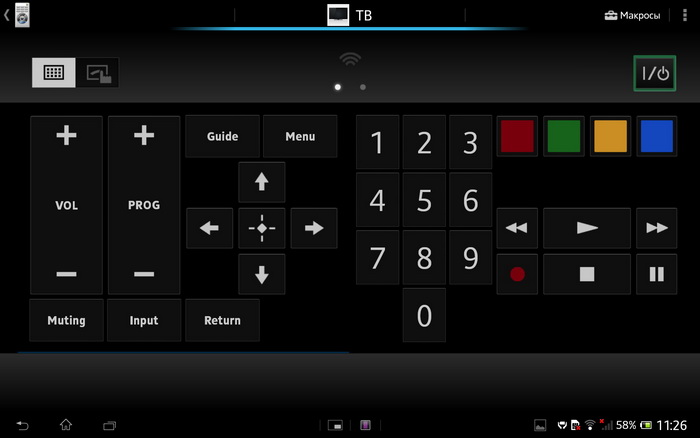
Of course, there are other cute little things, like Playstation certification, connecting the Dualshock 3 game controller, duplicating the contents of the screen on a TV, etc. But to me personally, they are not very clear and necessary. Although, probably, there will be connoisseurs.

So everything is fine, is iOS defeated by convenience? Unfortunately, not completely. When Sony’s improvements end, Android’s phone essence begins to climb from all angles. Most applications and widgets are not able to properly support the FullHD-screen, and something looks too small, and something, on the contrary, is senselessly gigantic. The notification system, logical for the phone, on a huge screen looks, at least, strange. The Sony keyboard, which is extremely comfortable on the phone, migrated to the tablet unchanged, and there is no hard sign on the layout. It is clear that on the telephone screen there was simply nowhere to put it, but then?
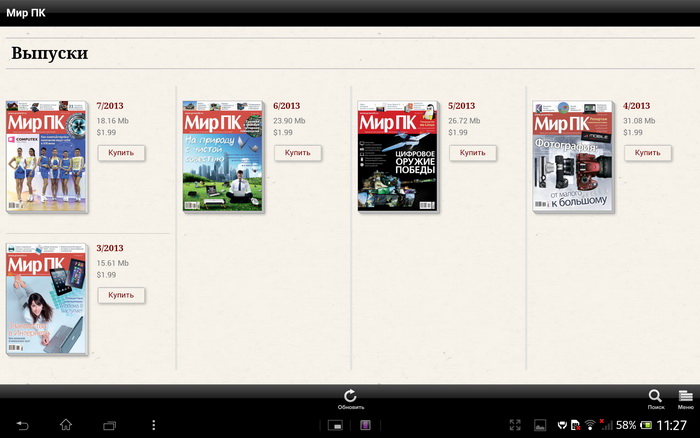
Some applications stretch quite harmoniously.
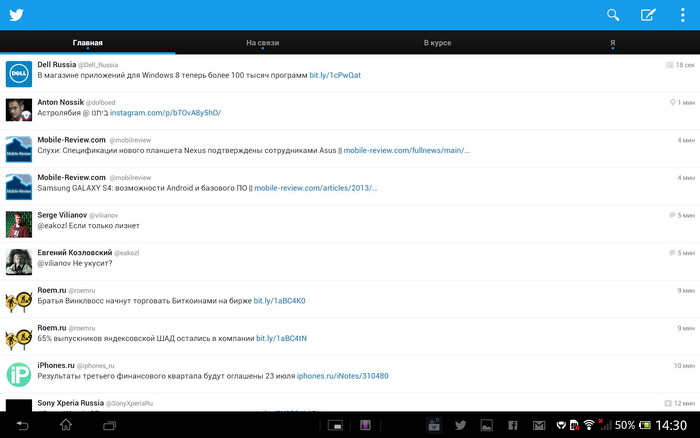
But, for example, the official Twitter client looks just idiotic.
Obviously, in most disharmonies Sony is not at all to blame, and rewriting Android from scratch is still a task. And yet, the user does not care about the problems of manufacturers of hardware and software. If the user experience is limping, the money transfer just won't take place, that's all. Or take place, but in a different pocket. Google phones with the support of device manufacturers have somehow managed to cope, it’s convenient to use them. But when will the turn come to tablets? Or does the Google leadership honor Jobs’s covenant to focus on one thing and only switch after a complete victory? Well, we’ll find out after the announcement of Android 5.0.
About personal
A significant part of my life goes on the road, and constantly carrying my backpack with me, I slowly began to pick up the lightest equipment. The first victim was a SLR camera, which was completely replaced by the Sony DSC-RX100 compact. Then, instead of the ingenious, but rather weighty Thinkpad, an ultrabook and an Intel Atom tablet appeared, which I take with me in turn, depending on the length and “load” of the trip. Finally, instead of a large iPad, I gradually began to carry the iPad mini.
Throwing Tablet Z into a backpack without a case is dangerous - even though the screen is protected from scratches, its size attracts solid objects lying in the neighborhood. And that means in one unpleasant moment they may touch too intensely. The branded case looks nice and even knows how to turn on / off the screen when the cover is lifted, but the tablet in it takes up about the same space as two iPad mini. Not critical, of course, but if for increasing the volume, for example, the battery life was increasing, I would take it more calmly.
For several years I have said that Android and iOS are parallel universes, and devices on one platform cannot completely replace others.
Having walked around and traveled with the Tablet Z, I have to admit: the universes intersected, and the replacement is quite real. Especially after Google connected all of their IM services in multi-platform Hangouts, saving me from being tied to iMessage and Facetime (unfortunately, other applications of this kind did not take root for various reasons).

All that is needed is here.
The remaining restrictions are more aesthetic. In the end, the Korean and Japanese cars are very similar in functionality, but Toyota is imperceptibly better than Hyundai (please do not be offended by the owners of Hyundai). Funnily enough, the Sony tablet in this case acts as a Korean car. It works, rides, does not break, rushes along the highway like a hurricane - but not Toyota.
An unusual aftertaste remains after a month with the Sony Tablet Z. It seems to be not an ideal device, but I don’t want to let it out of my hands. This usually happens with devices whose developers thought a little beyond technical specifications.
For the final move, I would like all the features of the Tablet Z in a more compact body. For example, an 8-inch without these weird frames on the sides of the screen.
But while it is possible to rejoice from the bottom of our hearts, like Sony, it has already been decommissioned, it makes one smart mobile device after another. As far as I know, for the company this is not quite a business yet (the mobile unit spends substantially more than it earns), and I am very worried that the fuse will not end. Because it’s precisely these devices on which the coinage of the developers’s souls rests that we really lack.
PS The average price of the version with LTE in Moscow is 26 thousand rubles. Without LTE - 22 thousand. Copies from gray supplies can be purchased for 22.5 and 19.5 thousand, respectively.
In January of this year, Sony showed the Xperia Z smartphone at CES. A wave of enthusiasm swept across the Internet. “The best Android device in the entire history of the platform,” “What iPhone 5 should have been,” “The triumph of design and hardware capabilities,” as gadget writers called it. I, too, was at that presentation in Vegas and, holding the device in my hands, I decided to postpone the enthusiasm until thoughtful acquaintance with the final version. And then all these first glances at the preliminary reviews, frankly speaking, slightly lifted up all but young SMM experts.
After the Xperia Z went on sale, the same authors began to scold him. Mainly for insufficient viewing angles. To me, this claim seems a little strange. With the current screen sizes for top-end smartphones (5 inches!), Text and pictures from them are perfectly visible from a distance of a couple of meters. If you drive in a car - that's okay. If you travel by public transport, and even at rush hour, the neighbors are happy to read a book, mail, Twitter, Facebook and look at pictures with you. The viewing angles of the Xperia Z are noticeably wider than they are described in the forums. But, really, it’s not very easy to see the information on the screen from the side. And this makes the smartphone, a personal computer of the beginning of the XXI century, truly personal. Although, probably, some network exhibitionists are annoyed.

I myself have been using Xperia Z as a second smartphone for several months and consider it the best of all that has ever happened with Android. This is a very integral device, the developers of which have good taste and common sense. It is practical, elegant, stable - and, in addition, photographs well. Do not forget about moisture resistance. Indeed, it is very convenient when you can get into the rain without fear with the phone, not to mention more ... intimate situations. A quick battery was causing some disharmony, but, firstly, all the flagships are guilty of this, and, secondly, the recently released firmware with Android 4.2.2 substantially corrected the situation. I got the feeling that the Xperia Z picked up a banner that fell out of the hands of the Samsung Galaxy S III. It was this Korean device that at one time very pleased with accuracy and thoughtfulness, however, in S4, developers are overly addicted to performance at the expense of efficiency. There are many whistles and rattles, but they fit sluggishly into everyday life. Xperia Z is almost devoid of jewelry, but the whole
At MWC, they showed the Tablet Z tablet, made in the same aesthetics as the Xperia Z. They are really very similar, like a smartphone stretched to a 10-inch diagonal screen, along the way, slightly changing the proportions. And the filling is very similar. Colleagues began to praise him, but again I preferred to wait for the final version. The fact is that I have a rather complicated relationship with Android tablets. There is no doubt that in terms of functionality, the Google platform is equal to iOS, and in some ways has overtaken. But according to the degree of ease of use on tablets, until the last moment everything was pretty sad. No matter how archaic the iPad interface seems, it is very convenient to use it. And Android ... Small spaces, up to 5 inches inclusive, the platform serves well. But it is worth exceeding this threshold, as the telephone interface begins to look ridiculous. This endless segmentation of devices on Android is affecting, which does not allow you to make widgets, applications and icons once and for all. And, of course, to do well. So, such high-tech Christmas toys are obtained at the exit: you can use it, but there is no joy.
I have been using the Sony Tablet Z for about a month now, and I must say that this is a very big step towards the user for the Android tablet. Maybe even too big. But let's talk about everything in order.
About iron
As I wrote above, from a hardware point of view, the Tablet Z is very similar to the Xperia Z. Everything works on a Qualcomm quad-core processor with exactly the same frequency as in a smartphone (1512 MHz). In the official specifications, in the first case it is called S4 Pro, and in the second, telephone, APQ8064 + MDM9215M, but I dare to assume that this is generally the same chip. The same graphics core and almost identical results in benchmarks hint at this (a study of the detailed description confirmed the correctness of the assumptions - the same Qualcomm APQ8064 + MDM9215M in Tablet Z). The amount of RAM is also the same, 2 GB.

If you look closely, in the background you can see the protruding corners of the Dell Latitude 10 tablet on Intel Atom and Windows 8. With the same dimensions and a slightly thicker case, it works on battery one and a half times longer ...
The resolution of the TFT-screen with a diagonal of 10.1 inches is 1920x1200 pixels. An additional strip of pixels is intended for the service strip. As in the Xperia Z, there are no hardware buttons here, and in order not to eat up the space at FullHD, we took such a step (the Xperia Z still eats away some of the screen). I really liked the matrix: the colors are natural, the viewing angles are enough to watch a movie with at least five, the margin of brightness is optimal. You can, of course, be sad that neither IPS nor AMOLED. Or you can just watch and have fun. A little puzzling is the wide frame around the screen, making the Tablet Z more bulky than we would like. Honestly, I do not really understand - why is this done? Certainly, the problem is not the lack of space for electronic filling: as we recall, it is almost identical to the telephone, and therefore free space should be a dime a dozen. According to the resultsopening the tablet , manufactured by Chipworks, it can be assumed that Sony either did not have time, or could not condense the arrangement of internal elements, which is why the case is full of voids. The late Jobs would probably have brought to tears for this and lowered him from the stairs (a video of the process of disassembling the Tablet Z can be seen here ).
This is especially strange combined with the desire of designers to make the case one of the thinnest in the world. It is really surprisingly thin - only 6.9 mm versus 7.9 for the Xperia Z. This gives an excellent impression, but the trouble is that you can’t defy such beauty without a cover, these very thin millimeters are not very noticeable in it ... In general, a strange impression. A feeling that just did not have time to bring to mind. At least for the next incarnation it turned out. At the same time, you can add a mirror substrate, and now the screen fades noticeably in the sun, although the tablet somehow asks for the beach.

All important openings are hidden under the plugs. In the new smartphone Xperia Z Ultra managed to do without plugging the headphone jack, but here the stub is still in place.
After all, the case in it is dust and moisture resistant. The level of protection is the same as that of Xperia Z: it is better not to swim in the sea, but the tablet can withstand short-term immersions in fresh water and work in a room with high humidity (in the bathroom, for example) without consequences. The main thing is not to forget to tightly close the plugs. They cover all openings except for speakers and a microphone, so it’s probably best not to be greedy and buy a dock for charging, otherwise pulling the plug back and forth will quickly begin to annoy. And in a fit of irritation it can once be torn off. In general, I already bought a docking station for a smartphone, since the question price is about 900 rubles. It will be necessary to see for the tablet, if we get along.
Speaking of speakers. There are two of them, and they are quite loud. So much so that without choking, they are able to cover a 10-meter room. But, unfortunately, only a small part of the mid-frequency spectrum is available to us, in which you can parse the voice of singers or actors, but the nuances of music or other soundtrack are very unlikely. Therefore, connoisseurs of high-quality sound will have to wear headphones, since the sound path is very decent and even 64-ohm models are well pumped. In general, the sound subsystem in Sony mobile devices is very pleasing. When I don’t take an iRiver Astell & Kern player with me, I listen to music exclusively on Xperia Z, where it sounds a little more analog and tube than on iPhone 5. By the way, the most advanced guys can connect fashion speakers with NFC support. The pairing process looks very impressive.

Tablet Z seems to be taking part in the competition for the most concise design of the back ...
Cameras, as expected, two pieces. The front gives a picture up to 1920 × 1080 pixels, inclusive. In Skype, Hangouts and other video chat applications, it behaves well. Fans of shooting dacface will also be pleased, lips are large and convincing. The main camera is 8-megapixel, with the mobile version of the Exmor R sensor. Mobility is achieved at a considerable price, and from the original Exmor R, in fact, only the name remains. No, except for jokes. The sensor of the same name is used, for example, in the Sony DSC-RX100 compact camera, and the picture quality there is an order of magnitude higher. Therefore, we reject the marketing husk and say simply: the camera is at the level of the flagship smartphones of the previous generation or slightly lower. You can shoot with pleasure, but in smartphones you can already find significantly more interesting options (at the last moment I found

There is a camera, no flash. However, in tablets it is not common.
There are two versions of the Tablet Z - only with WiFi or with LTE / 3G in the appendage. They gave me a second one for the experiments. There is nothing special to say here: everything works without incident. WiFi, however, is quite pessimistic, and gives out only one division where the iPad mini shows the maximum signal level. However, this does not affect the speed and stability of the connection. If the router supports the 5-gigahertz range, you can switch to it when watching HD movies over the air (for example, from a home NAS) - for greater stability. Unfortunately, the number of 2.4 GHz networks in large cities has already exceeded all reasonable limits, and they greatly interfere with each other.
The amount of on-board flash memory available to the user is about 10 GB. For applications and music, this is most likely enough, but for movies you will have to add a microSD card. The tablet easily digests even 64-gigabyte copies, so there should not be problems with a lack of space.
The battery capacity is at least 6,000 mAh (that’s exactly the “minimum” is written in the detailed description. It is possible that capacity will be increased in new revisions). The manufacturer promises up to 9.5 hours of video playback, but I do not advise you to flatter yourself. It is possible that such an indicator can be achieved, but only with the screen off and network interfaces turned off. If the screen is still not turned off, the battery will last for about 6 hours of continuous operation under load. And even a little less. Owners of iPads giggle maliciously and, in general, do the right thing. No, seriously - why wasn’t it possible to make a tablet a millimeter thicker? Given the area, this would increase the battery capacity by a good third, and then Tablet Z would confidently compete with the same iPad. I asked the Sony Mobile Chief Marketer about this, and he said something people are thirsty for a slim body and is ready for this for any restrictions. Marketers, of course, know better. But I, having bought a Sony branded case (not cheap, by the way, 3000 rubles), I no longer see and feel the vaunted subtlety. But the battery discharge is very noticeable. Moreover, it charges about the same as it works. Under normal conditions, it’s not scary - set it at night and forgot to sleep. But on trips sometimes upsets.

It is easy to see that the tablet (bottom) is really a little thinner than the Xperia Z smartphone (top).
At the same time, continuous operation is quite rare. Usually you watch movies in non-stop mode on a train or plane, and the rest of the time you use a tablet on raids. Turned on, poked for half an hour, laid it on the table. In this mode, the Tablet Z, according to the subjective feeling, lives no less than the iPad. To save battery power, you can enable Stamina mode, which disables all synchronization when the screen is off. And then - with a typical home use model - the tablet can be charged almost once a week.
Summing up the subtotal for the iron part, we can say that it is ... reasonable, although not perfectly balanced. There are no frills that can impress a young lover to buy miracle gadgets for daddy’s money. But in general, the hardware is decent, the performance of the tablet is pleasing to the eye. If only there would be a narrower frame around the screen, but the battery is more powerful - then it would be very good. But how many moisture resistant tablets with such characteristics do you know? That's it.
About software
When you turn on Tablet Z for the first time, you get the full feeling that you have an enlarged Sony smartphone in front of you. This feeling almost does not wane over time. Indeed - a set of applications, the color scheme, everything is exactly the same. This, in general, is not bad, because Sony’s taste is all right, and branded applications are made with high quality and I don’t especially want to replace them (except, perhaps, the video player, because the built-in shows excessive moodiness for the formats). Again, they didn’t forget about the weather widget, which fans of Sony smartphones really like (deservedly!) And some even don’t switch to alternative firmware because of it (the tricky widget does not start there).


In the upright position, the resemblance to a giant phone only intensifies.
The tablet works on Android 4.1.2. Version 4.2.2 is expected soon, and judging by the fact that it has already begun to be distributed to phones, it does not take long to wait. There is hope in a slight increase in battery life. If it worked on a smartphone, then suddenly a small miracle will happen?
The company launcher is simple, neat, and allows you to place up to 48 application icons on one screen mixed with widgets. There are five screens in total, so you can thoroughly settle in. Very useful were the mini-applications with which Sony has been experimenting since the last generation of smartphones. This is a cross between a full application and a widget. So, with one click you can call the calculator, window browser, timer, remote control, and if the pre-set is not enough - in Google Play you can download another fifty additional softinks. On the phone, they would have looked rather strange, but here just right. A nice example of "thinking" of Android.

The gadget launcher The mini

browser works on the background of cards

Using another gadget you can check whether everything is alright with the face

This is only part of a set of additional gadgets on Google Play.
I would also like to mention a proprietary application with the simple name “Dist. control". This, as you might guess, is a universal remote control. An infrared port is hidden on the upper edge of the Tablet Z, and this allows you to control almost any equipment. The database of devices in the database is simply huge, and there are not only televisions, but also players, receivers, speakers, etc. etc. If something suddenly doesn’t turn out, you can train the application manually by feeding him commands from the device’s native console. It seems to be nonsense, but very convenient. You used to lie on the couch, do research, and suddenly you want to watch the Rossiya TV channel. Well, to soak up optimism. To get up at the remote control is too lazy, and here is a raz - and turned it on in two clicks. Good!

Of course, there are other cute little things, like Playstation certification, connecting the Dualshock 3 game controller, duplicating the contents of the screen on a TV, etc. But to me personally, they are not very clear and necessary. Although, probably, there will be connoisseurs.

So everything is fine, is iOS defeated by convenience? Unfortunately, not completely. When Sony’s improvements end, Android’s phone essence begins to climb from all angles. Most applications and widgets are not able to properly support the FullHD-screen, and something looks too small, and something, on the contrary, is senselessly gigantic. The notification system, logical for the phone, on a huge screen looks, at least, strange. The Sony keyboard, which is extremely comfortable on the phone, migrated to the tablet unchanged, and there is no hard sign on the layout. It is clear that on the telephone screen there was simply nowhere to put it, but then?

Some applications stretch quite harmoniously.

But, for example, the official Twitter client looks just idiotic.
Obviously, in most disharmonies Sony is not at all to blame, and rewriting Android from scratch is still a task. And yet, the user does not care about the problems of manufacturers of hardware and software. If the user experience is limping, the money transfer just won't take place, that's all. Or take place, but in a different pocket. Google phones with the support of device manufacturers have somehow managed to cope, it’s convenient to use them. But when will the turn come to tablets? Or does the Google leadership honor Jobs’s covenant to focus on one thing and only switch after a complete victory? Well, we’ll find out after the announcement of Android 5.0.
About personal
A significant part of my life goes on the road, and constantly carrying my backpack with me, I slowly began to pick up the lightest equipment. The first victim was a SLR camera, which was completely replaced by the Sony DSC-RX100 compact. Then, instead of the ingenious, but rather weighty Thinkpad, an ultrabook and an Intel Atom tablet appeared, which I take with me in turn, depending on the length and “load” of the trip. Finally, instead of a large iPad, I gradually began to carry the iPad mini.
Throwing Tablet Z into a backpack without a case is dangerous - even though the screen is protected from scratches, its size attracts solid objects lying in the neighborhood. And that means in one unpleasant moment they may touch too intensely. The branded case looks nice and even knows how to turn on / off the screen when the cover is lifted, but the tablet in it takes up about the same space as two iPad mini. Not critical, of course, but if for increasing the volume, for example, the battery life was increasing, I would take it more calmly.
For several years I have said that Android and iOS are parallel universes, and devices on one platform cannot completely replace others.
Having walked around and traveled with the Tablet Z, I have to admit: the universes intersected, and the replacement is quite real. Especially after Google connected all of their IM services in multi-platform Hangouts, saving me from being tied to iMessage and Facetime (unfortunately, other applications of this kind did not take root for various reasons).

All that is needed is here.
The remaining restrictions are more aesthetic. In the end, the Korean and Japanese cars are very similar in functionality, but Toyota is imperceptibly better than Hyundai (please do not be offended by the owners of Hyundai). Funnily enough, the Sony tablet in this case acts as a Korean car. It works, rides, does not break, rushes along the highway like a hurricane - but not Toyota.
An unusual aftertaste remains after a month with the Sony Tablet Z. It seems to be not an ideal device, but I don’t want to let it out of my hands. This usually happens with devices whose developers thought a little beyond technical specifications.
For the final move, I would like all the features of the Tablet Z in a more compact body. For example, an 8-inch without these weird frames on the sides of the screen.
But while it is possible to rejoice from the bottom of our hearts, like Sony, it has already been decommissioned, it makes one smart mobile device after another. As far as I know, for the company this is not quite a business yet (the mobile unit spends substantially more than it earns), and I am very worried that the fuse will not end. Because it’s precisely these devices on which the coinage of the developers’s souls rests that we really lack.
PS The average price of the version with LTE in Moscow is 26 thousand rubles. Without LTE - 22 thousand. Copies from gray supplies can be purchased for 22.5 and 19.5 thousand, respectively.
